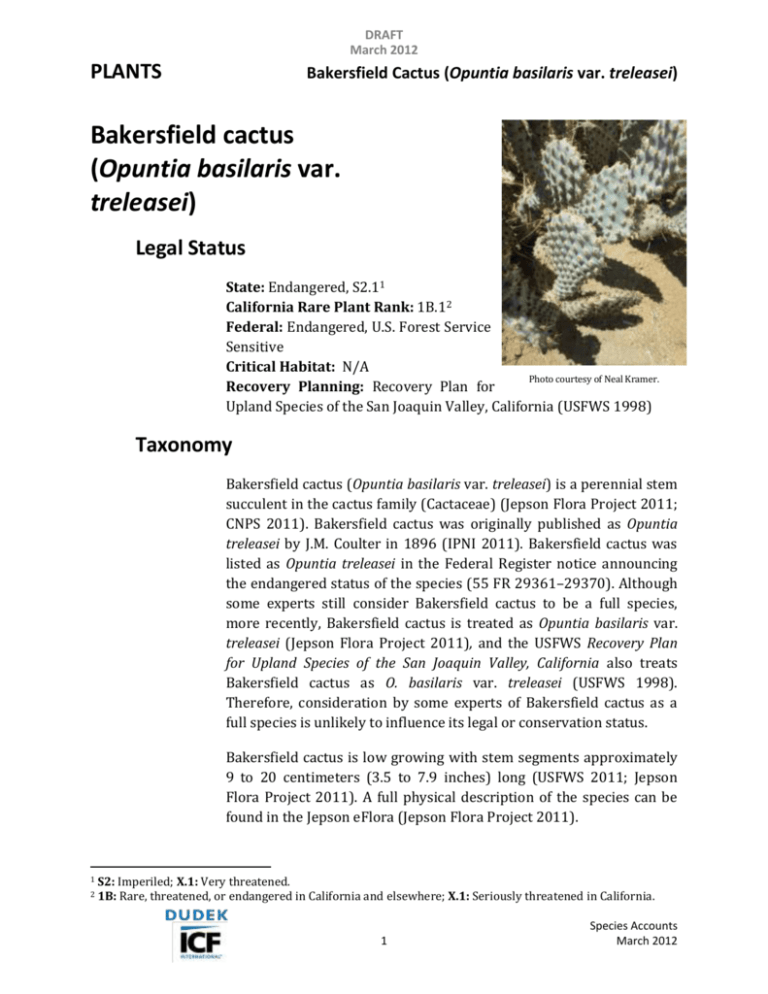Bakersfield cactus
advertisement

DRAFT March 2012 PLANTS Bakersfield Cactus (Opuntia basilaris var. treleasei) Bakersfield cactus (Opuntia basilaris var. treleasei) Legal Status State: Endangered, S2.11 California Rare Plant Rank: 1B.12 Federal: Endangered, U.S. Forest Service Sensitive Critical Habitat: N/A Photo courtesy of Neal Kramer. Recovery Planning: Recovery Plan for Upland Species of the San Joaquin Valley, California (USFWS 1998) Taxonomy Bakersfield cactus (Opuntia basilaris var. treleasei) is a perennial stem succulent in the cactus family (Cactaceae) (Jepson Flora Project 2011; CNPS 2011). Bakersfield cactus was originally published as Opuntia treleasei by J.M. Coulter in 1896 (IPNI 2011). Bakersfield cactus was listed as Opuntia treleasei in the Federal Register notice announcing the endangered status of the species (55 FR 29361–29370). Although some experts still consider Bakersfield cactus to be a full species, more recently, Bakersfield cactus is treated as Opuntia basilaris var. treleasei (Jepson Flora Project 2011), and the USFWS Recovery Plan for Upland Species of the San Joaquin Valley, California also treats Bakersfield cactus as O. basilaris var. treleasei (USFWS 1998). Therefore, consideration by some experts of Bakersfield cactus as a full species is unlikely to influence its legal or conservation status. Bakersfield cactus is low growing with stem segments approximately 9 to 20 centimeters (3.5 to 7.9 inches) long (USFWS 2011; Jepson Flora Project 2011). A full physical description of the species can be found in the Jepson eFlora (Jepson Flora Project 2011). 1 2 S2: Imperiled; X.1: Very threatened. 1B: Rare, threatened, or endangered in California and elsewhere; X.1: Seriously threatened in California. 1 Species Accounts March 2012 DRAFT March 2012 PLANTS Bakersfield Cactus (Opuntia basilaris var. treleasei) Distribution General Bakersfield cactus occurs in the Tehachapi Mountain area and the southeastern San Joaquin Valley in Kern County, California (Figure SPP6; Jepson Flora Project 2011). The historical distribution of Bakersfield cactus was likely more or less continuous east of Bakersfield, from Granite Station south to Comanche Point, east to Caliente, and west to Oildale (USFWS 1998, 2011). However, it is currently restricted to a limited area of central Kern County near Bakersfield in the southern San Joaquin Valley, where the remaining populations occur in 11 general areas (USFWS 2011). Approximately one-third of the historical population has been extirpated (USFWS 1998). The California Natural Diversity Database (CNDDB) includes 46 occurrences, of which 6 are in the Plan Area (CDFG 2012a). Distribution and Occurrences within the Plan Area Historical Of the six occurrences documented in the CNDDB within the Plan Area, one is considered historical with plants that have not been observed since 1934. This occurrence is mapped approximately 1 mile south of Fram (CDFG 2012a; Figure SP-P6). The historical occurrence in the Plan Area is the east of the recent occurrences described below. Recent The recent occurrences of Bakersfield cactus reported in the Plan Area by the CNDDB occur at Oak Creek Pass in the Tehachapi Mountains, and near West Antelope Station and east of Bean Canyon at the foothills of the Tehachapi Mountains (Figure SP-P6; CDFG 2012a). Three of these occurrences are located on private land; ownership of the other two is unknown (CDFG 2012a). These five occurrences are all very new, found in 2009 and 2010, and extend the variety’s known range southeast since they occur south of Comanche Point and east of Caliente, which were considered the range limits in 1987 according to the 5-Year Review (USFWS 2011). 2 Species Accounts March 2012 DRAFT March 2012 PLANTS Bakersfield Cactus (Opuntia basilaris var. treleasei) Natural History Habitat Requirements Bakersfield cactus grows primarily in chenopod scrub, but is also found in valley and foothill grassland; and occasionally in cismontane woodland, including blue oak woodland and riparian woodland (CNPS 2011; USFWS 2011; CDFG 2012a; Jepson Flora Project 2011). Some associated species include California filago (Filago californica), yellow pincushion (Chaenactis glabriuscula), and red brome (Bromus madritensis ssp. rubens), as well as other nonnative annual grasses (USFWS 2011). Bakersfield cactus occurs on floodplains, ridges, bluffs and low rolling hills, and flats (USFWS 2011; CDFG 2012a). Soils are sandy or gravelly with little silt and clay, are low in organic matter, and may contain cobbles or boulders (CNPS 2011; USFWS 2011); they are granitic and well-drained (CDFG 2012a). Bakersfield cactus ranges from 90 to 1,140 meters (295 to 3,740 feet) (CNPS 2011; CDFG 2012a). Table 1 lists primary habitat associations and parameters for Bakersfield cactus. Table 1. Habitat Associations for Bakersfield Cactus Land Cover Type Saltbush scrub, grassland, blue oak woodland, and riparian woodland Habitat Designation Habitat Parameters Supporting Information Primary Coarse welldrained sandy or gravelly soils, from 90 to 1,140 meters (295 to 3,740 feet) elevation CNPS 2011; CDFG 2012a; USFWS 2011 Reproduction Bakersfield cactus blooms from April to May (CNPS 2011). Though not certain for this variety, some other prickly-pear species (Opuntia spp.) require cross-pollination for seed-set and many are pollinated by bees. Bakersfield cactus exhibit several features that are 3 Species Accounts March 2012 DRAFT March 2012 PLANTS Bakersfield Cactus (Opuntia basilaris var. treleasei) characteristic of bee pollination: flowers are large and showy with a watermelon-like odor; it has a long flowering period; and produces large amounts of nutritious pollen from numerous stamens (Jepson Flora Project 2011; Grant and Grant 1979). Flowers of beavertail prickly-pear (Opuntia basilaris var. basilaris) are commonly visited by beetles and bees, but are pollinated mainly by bees (Grant and Grant 1979). The native solitary bee, Diadasia australis ssp. california, is a potential pollinator of Bakersfield cactus (USFWS 2011). This bee is known to occur in Kern County and specializes in collecting pollen from prickly-pear species. Diadasia bees in general are oligolectic (exhibit a narrow, specialized preference for pollen sources), with some specializing on cactus species. The little cactus bee (Diadasia rinconis) has been recorded as a visitor to Bakersfield cactus (Grant and Grant 1979). Bakersfield cactus typically undergoes vegetative reproduction—the production of new plants from sources other than seed—and produces seeds infrequently. Fallen pads can take root. Cactus pads may be dispersed by flood waters. Seed dispersal agents are unknown (USFWS 2011), but the fruits and vegetative parts of Opuntia species in general, such as the spiny pad, are closely linked with seed dispersal and vegetative dissemination by animals (ReyesAgüero et al. 2006). Bakersfield cactus does not survive prolonged inundation (USFWS 2011). Ecological Relationships Competition with non-native grasses for water is likely the cause of the decline in the number of cactus pads and low rates of reproduction observed in recent population studies at Sand Ridge Preserve (USFWS 2011). A study conducted from 2002 to 2005 at Sand Ridge Preserve analyzed the effects of grass clipping and Fusilade II (a grass-specific herbicide) treatments on Bakersfield cactus survival, flower production, and recruitment. Bakersfield cactus declined on the control plots, and the rates of both vegetative and sexual reproduction were low, likely due to a reduction in soil moisture storage by nonnative annual grasses in years with below average precipitation. In contrast to the control plots, the number of cactus pads in the clipped 4 Species Accounts March 2012 DRAFT March 2012 PLANTS Bakersfield Cactus (Opuntia basilaris var. treleasei) plots and herbicide-treated plots increased (USFWS 2011). A decline in pollinators may be partly responsible for the low levels and infrequency of seed set observed (USFWS 2011). Predation of Bakersfield cactus is unknown, though it is not considered to a threat to this species (USFWS 2011). In Mexico, the seed and fruits of other Opuntia species are consumed primarily by rodents, but also by harvester ants, birds, and other mammals (González-Espinosa and Quintana-Ascencio 1986). Population Status and Trends Global: G5T2, Variety is imperiled (NatureServe 2011, conservation status last updated in 1990) State: S2.1, Imperiled (CDFG 2012b) Once likely more or less continuous east of Bakersfield, the current range of Bakersfield cactus consists of scattered fragments of these once larger populations (USFWS 2011). Of the 46 reported occurrences reported in CNDDB, 8 are extirpated and 1 is possibly extirpated (CDFG 2012a). Though the total population of Bakersfield cactus was not estimated historically, densely spaced clumps of cactus once covered an estimated area of 2 square miles from the Caliente Creek floodplain onto Sand Ridge (USFWS 2011). When known sites were inventoried in 1989, fewer than 20,000 clumps of Bakersfield cactus were estimated to remain. Only four areas had populations of 1,000 clumps or more: Comanche Point, Kern Bluff, Sand Ridge, and the area north of Wheeler Ridge (USFWS 2011). A status survey in 2010 and 2011 was conducted to determine the current state of the historical occurrences of Bakersfield cactus throughout its range (USFWS 2011; Cypher et al. 2011). Based on these surveys which focused on existing CNDDB occurrences, 25 occurrences are confirmed extant, 11 are believed to be extirpated, the status of 3 could not be determined, 2 previously unreported populations were documented, and 6 undocumented translocated populations were identified. Therefore, there is a minimum of 33 extant occurrences (Cypher et al. 2011). 5 Species Accounts March 2012 DRAFT March 2012 PLANTS Bakersfield Cactus (Opuntia basilaris var. treleasei) Threats and Environmental Stressors Agricultural land conversion, oil development, sand mining, urbanization, off-road vehicle use, proposed flood control basins, telecommunication and electrical lines construction, and possibly wildfires were considered threats to Bakersfield cactus habitat at the time of its listing in 1990 (USFWS 2011). Currently, the loss and modification of habitat from agricultural conversion and urban, especially residential, development remain the largest threats to Bakersfield cactus (USFWS 2011). Threats today also include oil development, off-road vehicle use, sand mining, and competition from non-native grasses. In addition, climate change, air pollution (including elevated nitrogen deposition), loss of pollinators, flooding, and loss of genetic diversity have been identified as potential new threats (USFWS 2011). Conservation and Management Activities A recently-completed survey has provided updated information on the status of known occurrences, confirming at least 33 current occurrences (Cypher et al. 2011). In 1990, The Nature Conservancy doubled the size of the Sand Ridge Preserve to 270 acres by acquiring a remnant of the Caliente Creek wash at the eastern base of the ridge. In 1997, the preserve was transferred to the Center for Natural Lands Management (USFWS 2011; CNLM 2011). Since 1993, with implementation of the Metropolitan Bakersfield Habitat Conservation Plan, several colonies of Bakersfield cactus have been acquired. The Implementation Trust for the Metropolitan Bakersfield Habitat Conservation Plan has protected parts of occurrences within the Kern Bluffs and Sand Ridge recovery sites (USFWS 2011). Negotiations over the proposed Department of Water Resources (DWR) Habitat Conservation Plan (HCP) for the California Aqueduct right-of-way are currently stalled with no target date for HCP completion (Grunewald 2011). The approximately 100,000-acre Wind Wolves Preserve at the very southern end of the San Joaquin Valley is owned and run by the 6 Species Accounts March 2012 DRAFT March 2012 PLANTS Bakersfield Cactus (Opuntia basilaris var. treleasei) Wildlands Conservancy. There are approximately 50 acres of presumed occupied Bakersfield cactus habitat on the Wind Wolves Preserve within the Wheeler Ridge recovery site (USFWS 2011). Tejon Ranch Corporation negotiated with national conservation groups on a preservation agreement, executed on June 17, 2008, in which Tejon Ranch Corporation committed to placing aside 178,000 acres through a combination of dedicated and designated project open spaces and allowing the conservation organizations to purchase up to an additional 62,000 acres at State-appraised cost. The conservation easement established through the agreement would result in the permanent conservation of almost 90% of the Ranch (USFWS 2011). The California Native Plant Society (CNPS) transplanted Bakersfield cactus clumps from sites proposed for development to Sand Ridge Preserve and the California Living Museum in Bakersfield. In addition, a few of the cactus clumps growing on the East Hills Mall site in Bakersfield were removed prior to mall construction, then replanted in a display bed after construction. No monitoring of transplanted individuals has occurred at any of the sites to determine survival rates or reproductive success (USFWS 1998). Data Characterization Distribution of Bakersfield cactus is not well known. It likely occurs in additional locations that have not been documented considering there is a lot of potential habitat that has not been surveyed, primarily because this habitat occurs on private land (Cypher et al. 2011). Although inferences can be made from other Opuntia species, the reproductive biology of Bakersfield cactus has not been studied directly (USFWS 2011). Though seeds are likely dispersed by animals based on other Opuntia species (Reyes-Agüero et al. 2006), seed dispersal agents for Bakersfield cactus are unknown, (USFWS 2011). Because no population surveys have been conducted recently in the Bakersfield cactus recovery areas (with the exception of Sand Ridge Preserve), the rates of reproduction at most sites are unknown (USFWS 2011). 7 Species Accounts March 2012 DRAFT March 2012 PLANTS Bakersfield Cactus (Opuntia basilaris var. treleasei) Management and Monitoring Considerations The USFWS 5-year review identified the following five highest priority actions to be implemented over the next 5 years to achieve progress toward recovery (USFWS 2011): 1. Protect populations within Bakersfield City limits in the Kern Bluff area and south of Highway 178 2. Work with willing landowners to establish a conservation easement or fee title to the property at the mouth of Kern Canyon 3. Complete the draft Department of Water Resources Habitat Conservation Plan 4. Conduct census of known populations and monitor the reproductive status of known populations 5. Determine suitable management methods for reducing non-native annual grasses and increasing native perennials, including Bakersfield cactus, and communicate the benefits of such management to rangeland landowners. Predicted Species Distribution in Plan Area There are approximately 547,241 acres of modeled suitable habitat for Bakersfield cactus in the Plan Area. Modeled suitable habitat occurs in the Eastern Slopes and Tehachapi-Piute Mountains ecoregion subsections, from 300 to 4,000 feet. Suitable habitat includes grassland, riparian, scrub and chaparral, and woodland communities with sandy or gravelly soils. Appendix C includes specific model parameters and a figure showing the modeled suitable habitat in the Plan Area. Literature Cited 55 FR 29361–29370. Final rule: “Endangered and Threatened Wildlife and Plants; Determination of Endangered or Threatened Status for Five Plants from the Southern San Joaquin Valley.” July 19, 1990. 8 Species Accounts March 2012 DRAFT March 2012 PLANTS Bakersfield Cactus (Opuntia basilaris var. treleasei) CDFG (California Department of Fish and Game). 2012a. “Opuntia basilaris var. treleasei.” Element Occurrence Query. California Natural Diversity Database (CNDDB). RareFind, Version 4.0 (Commercial Subscription). Sacramento, California: CDFG, Biogeographic Data Branch. Accessed February 2012. CDFG. 2012b. Special Vascular Plants, Bryophytes, and Lichens List. CNDDB. January 2012. Accessed February 2012. http://www.dfg.ca.gov/biogeodata/cnddb/pdfs/SPPlants.pdf. CNLM (Center for Natural Lands Management). 2011. “Preserve – Sand Ridge.” Accessed December 28, 2011. http://www.cnlm.org/cms/index.php?option=com_content&ta sk=view&id=68&Itemid=214. CNPS (California Native Plant Society). 2011. “Opuntia basilaris var. treleasei.” Inventory of Rare and Endangered Plants. Online ed. Version 8-01a. Sacramento, California: CNPS. Accessed November 2011. http://www.cnps.org/inventory. Cypher, B.L., E.N. Tennant, C.L. Van Horn Job, and S.E. Phillips. 2011. Status Survey for Bakersfield Cactus (Opuntia basilaris var. treleasei). Prepared for U.S. Bureau of Reclamation, Central Valley Project Conservation Program, Agreement Number R10AC20716. California State University, Stanislaus: Turlock California. September 29, 2011. González-Espinosa, M. and P.F. Quintana-Ascencio. 1986. “Seed predation and dispersal in a dominant desert plant: Opuntia, ants, birds, and mammals.” in Fugivores and Seed Dispersal. Estrada, A. and Flemin, T.H. (eds.). Dordrecht: Dr W. Junk Publishers. Grant, V. and K.A. Grant. 1979. “Pollination of Opuntia basilaris and O. littoralis.” Plant Systematics and Evolution 132:321–325. Grunewald, C. 2011. “California Department of Water Resources San Joaquin Field Division HCP.” Accessed December 28, 2011. http://www.snre.umich.edu/ecomgt/cases/pubs/hcp/Departm ent%20of%20Water%20Resources%20San%20Joaquin%20Fie ld%20Division%20HCP%20(HCP).pdf. 9 Species Accounts March 2012 DRAFT March 2012 PLANTS Bakersfield Cactus (Opuntia basilaris var. treleasei) Jepson Flora Project. 2011. “Opuntia basilaris var. treleasei.” B.D. Parfitt, ed. Jepson eFlora [v. 1.0]. Berkeley, California: University of California. Accessed December 5, 2011. http://ucjeps.berkeley.edu/IJM.html. NatureServe. 2011. “Opuntia basilaris var. treleasei.” NatureServe Explorer: An Online Encyclopedia of Life. Version 7.1. Arlington, Virginia: NatureServe. Last updated July 2011. Accessed November 2011. http://www.natureserve.org/explorer. Reyes-Agüero, J.A., J.R. Aguirre R., A. Valiente-Banuet. 2006. “Reproductive biology of Opuntia: A review,” Journal of Arid Environments 64(4):549–585. USFWS (U.S. Fish and Wildlife Service). 1998. Recovery Plan for Upland Species of the San Joaquin Valley, California. Portland, Oregon: USFWS, Region 1. USFWS. 2011. Bakersfield Cactus, 5-Year Review: Summary and Evaluation. Sacramento, California. September 2011. Accessed November 29, 2011. http://ecos.fws.gov/docs/ five_year_review/doc3888.pdf. 10 Species Accounts March 2012








